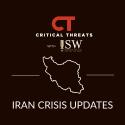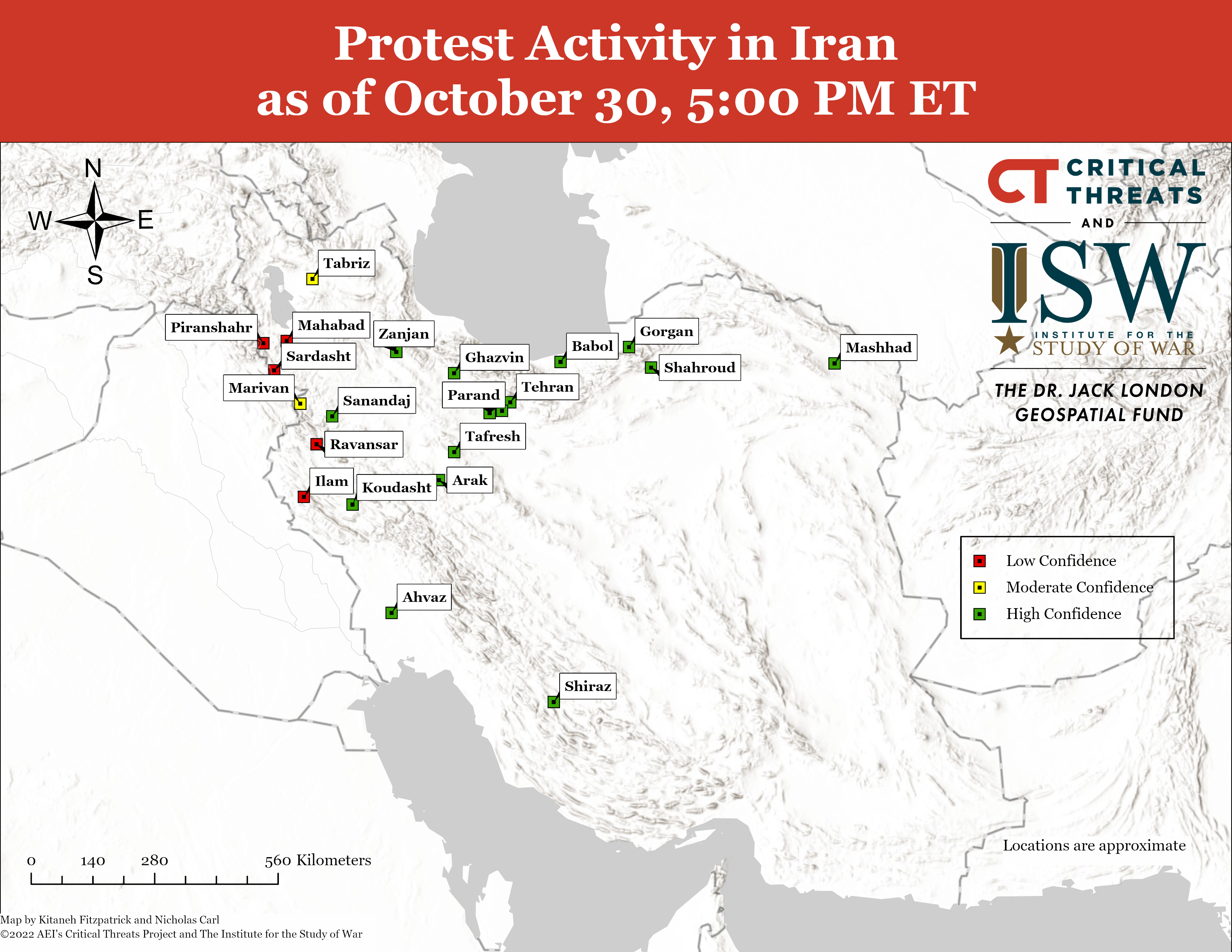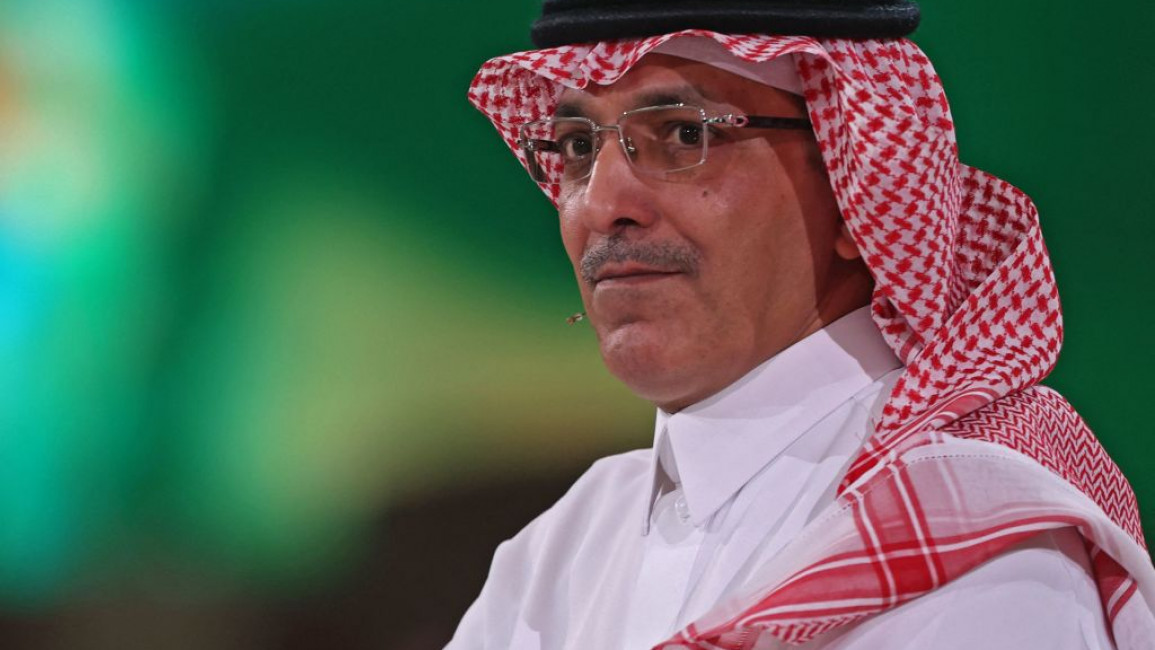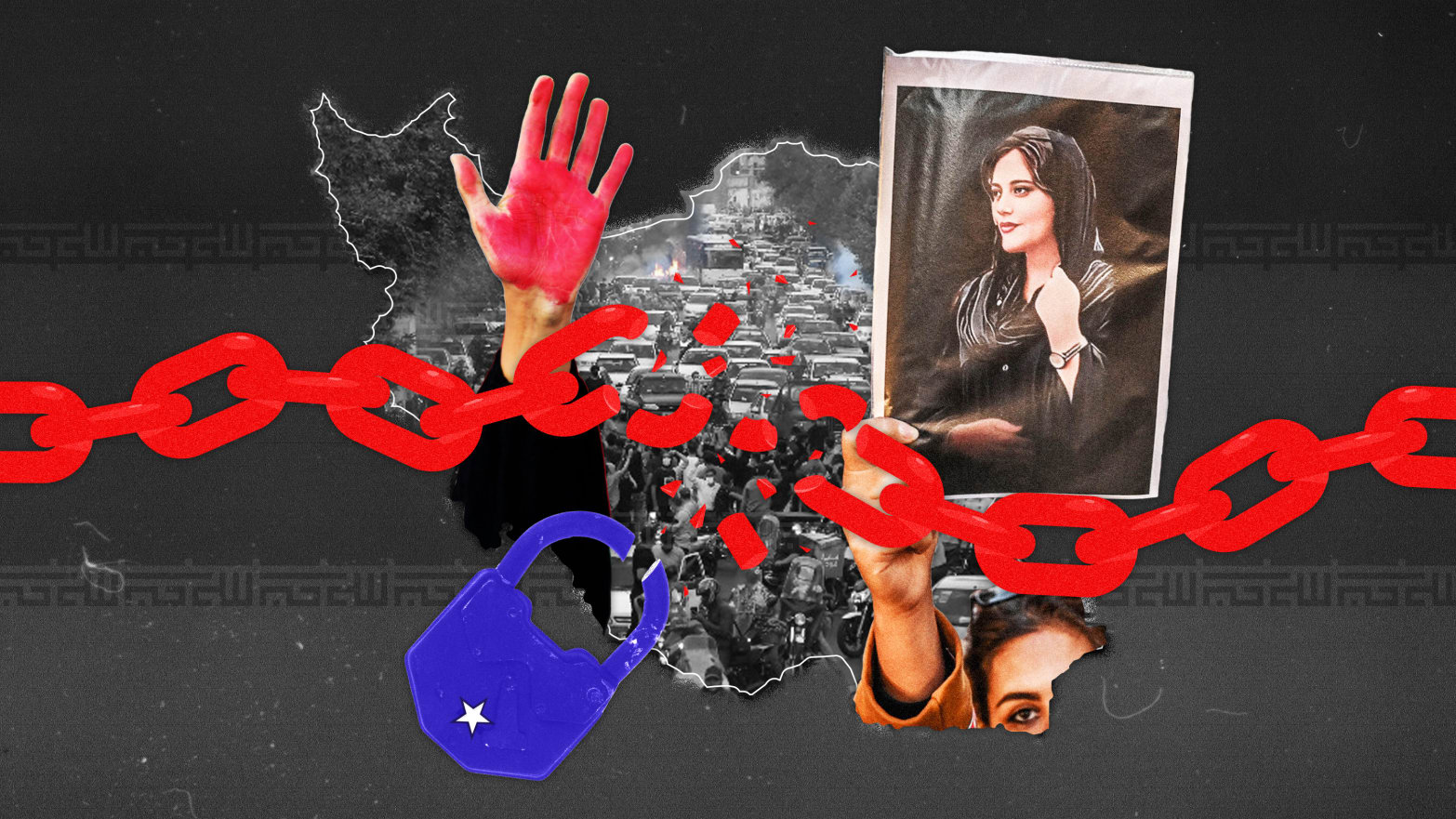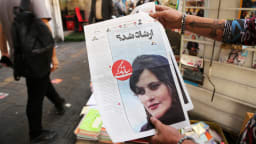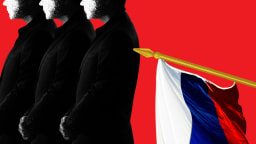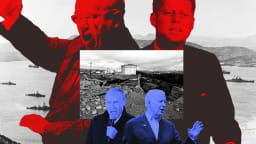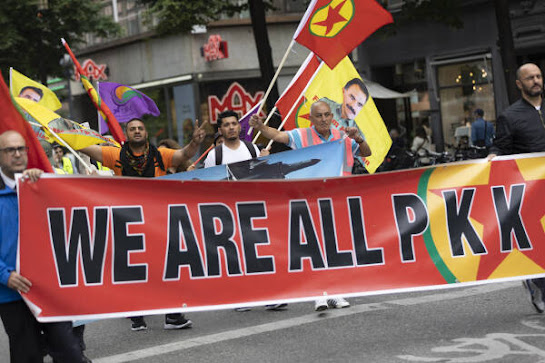
The death of university student Jina Mahsa Amini has triggered a wave of protests across Iran. For the last five weeks, the women of the country have been leading the way, but people from all walks of life have joined them. Are they the force that could bring down the regime?
21.10.2022,
For dancing in the streets freely. For our fear of kissing our loved ones. For my sister, your sister, our sisters.- From the protest song "Baraye" ("For"), by Shervin Hajipour
When night falls over Tehran, the people elevate their voices, says Anoush. They step out onto their balconies or head up to the rooftops. Someone begins chanting: "Death to the dictator!" And: "Woman! Life! Freedom!" Others join in, until the streets of the Iranian capital are filled with their calls.
It's been like this for the last five weeks. Ever since the 22-year-old Jina Mahsa Amini died on September 16 after the Iranian morality police took her into custody for allegedly "unislamic" dress, women across the country have been rising up – joined by a significant number of men – against the Islamist dictatorship.
Anoush, in her mid-20s, is one of these women. She has chosen a pseudonym to avoid putting her relatives in danger. She has become part of a revolt that has pushed the Islamist regime against the wall to a degree not seen since the mullahs took power in 1979. It is a revolt launched by women. In a state that systematically oppresses women, they are fighting for their freedom and against a theocratic regime that is held in contempt by much of the population

triggered the nationwide protests. Foto: Social Networks / ZUMA Wire / IMAGO
Anoush says she comes from a middle-class family in northern Iran. Her parents are conservative Muslims, she says, and have consistently warned her against any form of activism and beseeched her to never join a protest. Anoush works as a teacher and enjoys traveling in her free time, she says, and has made trips to Prague, southern Germany and Istanbul. Photos in social media show a young woman with hair that varies between colorful and black, long and short. Instead of wearing a hijab, she ties colorful scarves around her head that barely cover her hair at all. Her body is covered in tattoos that she is unable to show back home.
She is reachable via WhatsApp when the internet allows for it, the regime doing what it can this autumn to either block the web entirely or to at least restrict access. Anoush tells her story in perfect English. Later, in the middle of the night, a long message arrives in which she excuses herself for having been so emotional.
She was arrested for the first time when she was 18, Anoush says. It was during her first year at the University of Tehran, and she was stopped on the street by the morality police because of her inadequate hijab. Too much hair was visible and the hijab wasn’t large enough, she was told.
She was kept at the station for five hours on that occasion, she says. The police filed a criminal complaint and took photos of her, with the sign she was forced to hold reading: "insufficient hijab." Ultimately, she was given a choice: Either she could sign a document saying that she would never again do such a thing and call her parents so that they could bring her long, Islamic clothing. Or she could opt for jail.
For Anoush, the arrest was just one of many painful experiences as a woman in Iran. She remembers being beat up at school for wearing makeup or for showing her hair. She tells the story of a wedding that ended with the bride in tears because the police had stormed the reception and arrested the groom after alcohol was served. She talks about being prevented by the police from entering the university because her ankles were visible. Of being forced to wipe off her lipstick because it might provoke men. Over the phone, she says she could tell such stories for hours.
Already for the last six months, she says, she has frequently taken off her hijab while in public. "I am no longer that intimidated 18-year-old girl." Following Amini’s death, Anoush says, she simply couldn’t stand it any longer. "When the women of Iran decided to take to the streets against this dystopia – how could I not have participated?"
She says she has taken part in six demonstrations since then. Initially, she would wear a diving mask to protect her from the teargas, but she says she no longer does. Thus far, Anoush has been able to avoid the police at each of the protests she has participated in, disappearing into shops or into the apartments of older Iranians who keep their doors open for the protesters. "We are more afraid of being arrested than being killed," Anoush says. "When they arrest you, you don’t know what will happen to you. Sometimes, you can lie your way out again, and sometimes they torture you to death."
Despite the fear, though, Anoush senses that things are changing. "Now, when we go out onto the streets without a hijab, nobody can stop us any longer. There are too many of us," she says. Before the protests started, Anoush had wanted to leave Iran. But now, she says, she has understood that it’s not the country she hates, but the Islamic Republic. "For the first time, I have the feeling that the country belongs to us."
The protests continue to grow larger and larger, with schoolgirls and university students now involved, but also a number of men and even vendors in the bazaar. They are taking place in all regions of the country, in most of Iran’s large cities and even in the holy city of Qom. It is a movement that includes people from all layers of society and not just the upper classes in the capital, like previous protest movements.
In Tehran, young women are tearing off their hijabs on the street and cutting off their hair in protest. In the city of Mashhad, students are chanting: "We’re fighting! We’re staying! We’re taking back our country!" In Karaj, schoolgirls chased an officer from the schoolyard – and a video shows another group of girls holding up their middle fingers to a photo of Supreme Leader Ali Khamenei.
Following the manipulated presidential election in 2009, millions of Iranians took to the streets against the regime. It quickly came to be called the Green Revolution, but it was rapidly and violently put down. There were also protests in 2017/2018 against soaring food prices.
This time, though, the anger runs far deeper and is much more categorical. It is aimed at the Islamist regime itself, against its model for society, against the way it treats Iranian citizens, against the lack of future prospects and against the discrimination of minorities. It is no longer about reforms. The goal is that of getting rid of the regime in its entirety.
The regime is attempting to strike down the protests but has thus far not been successful. And even if it does manage to choke off the protests with brutality and mass arrests, the anger will persist.
Already, the women have managed to deal a blow to one of the most brutal dictatorships in the world, one which invests billions each year into its security apparatus. A dictatorship that has perfected its machinery of oppression and which throws the most intelligent people in the country into torture prisons.
Western clichés frequently portray Muslim women either as victims or fanatics, but the Iranian uprising is showing just how great their yearning for freedom and self-determination is. It is an inspiration for millions of women who suffer under patriarchal structures – in the Middle East and beyond.
Very little information about the uprising makes its way to the outside world, and what does come out is generally in the form of shaky mobile phone videos hastily filmed on street corners or from balconies. But there aren’t many of them, in part because the mullahs have largely shut down the internet, but also because there is an understanding among the protesters themselves that such videos are dangerous. The regime systematically uses them to track down demonstrators and arrest them.

Thus far, the protest movement has remained unstructured and there are no clear leaders.
DER SPIEGEL has maintained contact with around two dozen protesters over the last several weeks. The interviews have sometimes been conducted in writing with the help of encryption software, and sometimes by voice messaging, but rarely by phone. Sometimes, days will pass between sending a question and receiving a response. And as with Anoush, the real names of all of our interview partners must remain undisclosed for safety reasons. Many of the accounts are fragmentary – and yet they nevertheless provide a deep look into the inner workings of this revolt. Together, they combine to form an anatomy of an uprising.
The woman whose death triggered everything hadn’t planned to challenge the regime. On the early evening of September 13, Jina Mahsa Amani, a 22-year-old from the Kurdish region in of northwestern Iran, stepped out of the subway in Tehran. Her mother would later tell an Iranian journalist that her daughter had been wearing a long robe and a hijab.
Amini was there to visit relatives and to buy clothes for the university semester that was about to commence. It was, in fact, just a normal shopping trip – until, that is, she caught the attention of the morality police. They pulled her into their car, according to the account provided later by Amini’s younger brother Kiarash. He says he had wanted to intervene, but the police grabbed his arm and twisted it behind his back. He had to watch helplessly as his sister was taken away, together with other women whose clothing had been deemed "unislamic.”
Just a few hours later, Amini fell into a coma, and three days after that, she died. A photo shows the young woman lying in the hospital, with blood on her left ear.
The Iranian regime claims that Amini died of organ failure, allegedly as a consequence of an underlying health condition, which her family refutes. A video allegedly shows Amini staggering at the police station and trying to steady herself by grabbing a chair before collapsing. But there is much to indicate that she was a victim of violence: An eyewitness told Iranian journalists that Amani said while in custody that she had been hit in the head in the police car. Hackers leaked images of a CT scan that allegedly shows Amini’s fractured skull. Her family says that she also had wounds on her legs and that her face was swollen. For most people in Iran, it is clear what happened to her: The morality police killed her.
Amini is from the city of Saghez, located not far from the Iraqi border. She is known there by the first name Jina, which is what her family also calls her. In official identification papers, for which only Persian names are allowed, she is called Mahsa.
Pictures show a woman with soft features wearing dark red lipstick, her hijab loosely bound over her head, if she’s wearing one at all. Her relatives told journalists that Amini was not politically involved and had dreamed of leading a quiet, happy life. Her father is a civil servant and her mother a homemaker. An activist from Saghez says that Amini had yearned for a time when women and men could be free, and that she was a proud Kurdish woman. But according to all that is known about her, she never wanted to become a hero. And certainly not a martyr.
On the morning of Amini’s funeral, hundreds of furious people gathered in Saghez. Some of the mourners waved their headscarves and chanted: "Death to the dictator!" Their meaning was clear: Ayatollah Khamenei, the leader of the Iranian Revolution.
It’s no accident that the protests got their start in the Kurdish region of Iran. Resistance against the regime has a long tradition here. "Jin! Jiyan! Azadi! Woman! Life! Freedom!" – the demonstrators’ battle chant is actually a Kurdish rallying cry, deeply rooted in the Kurdish freedom movement or, more precisely, in the Kurdish women’s movement.
As they are in all countries in the region, the Kurds of Iran, who comprise around 10 percent of the population, are watched closely by the state. Just last year, there was a broad wave of arrests in the Kurdish areas, their demands for more self-determination and for the recognition of their culture being seen as a problem by the Iranian state. The uprising, which began in response to the death of a young, Kurdish woman, is also significant for Kurds in other countries of the Middle East, where they are also an oppressed minority. The most astounding element of the uprising is how quickly it spread to the rest of the population.
In Sanandaj, which is also located in the Kurdistan province, only just a few hundred people initially gathered on the market square in the wake of Amini’s death, chanting "Jin! Jiyan! Azadi!" Another mantra was: "Today it’s Jina. Tomorrow it’s us!"
Kaveh, an electrician in his early 30s, participated in these early protests. He and his wife Mina, a graphic designer, felt that it was impossible for them to remain silent. "Each of us could be killed tomorrow if we do nothing," he says.
But it wasn’t just the memory of Mahsa Amini that drove them to the streets. Economic suffering in the country is also a significant factor. And the lack of self-determination. The tight corset and the lack of prospects. Years of pent-up fury.
“For the first time, I have the feeling that the country belongs to us.”
The regime’s response came after two or three days. Security personnel rode toward the demonstrators on motorcycles, Kaveh and Mina among them, and struck everyone they could reach. Older people were also beaten, as were teenagers and children. Kaveh says they saw one man who had been beaten in his car, his brain splashed on the glovebox and blood dripping onto the asphalt.
One evening, police went after the couple on a bridge, with drones filming from above. "We know who you are. We will come get you at your homes at night." That was their message. "But we didn’t give up," says Mina. "We fled into the small streets of the nearby neighborhood."
Since then, their protest has resembled urban warfare. They sneak through the city streets, changing their clothes several times each day and with a constant eye to escape routes – which always involve just barely avoiding the regime’s minions.
What began in the Kurdish region quickly expanded to the capital and then to towns and cities across the country and throughout all of society – women and men, poor and rich, young and old, Muslim women, homosexuals.
Baran, for example, a young artist who likes reading history and who said over the phone that she has been waiting for a moment like this one for several years. For the first time, she says, she has joined protests with her entire family; for the first time, men have thrown their support behind the women. The fear has switched sides, she says: "We can sense that the regime is growing fearful."
Then there is the homemaker from Tehran who no longer dares to protest on the street after being shot in the leg by security during one demonstration. But she continues doing what she can from her home. "Every night at 9 p.m., we go to our window or onto the roof and sing," she says over the phone. "Everyone knows," she says, that 9 p.m. is the time for protesting. In some Telegram channels, merely posting the number 9 is enough. It means: "Turn out, sing, and don’t forget to wish death on Khamenei at 9 p.m."
Sahel is another, a feminist from Rasht in northern Iran who was hit in the back by eight shotgun pellets right at the beginning of the protests. Fearful of the regime’s henchmen, she received treatment at home from friends. Now, she is back at it. In a series of voice messages, Sahel recounts in her soft voice what she has experienced and describes how demonstrators who have never before taken to the streets are now learning how to build barricades. They are, she says, watching videos from Hong Kong to learn from the resistance movement there.
Nono, a non-binary person from Gilan Province in northern Iran, has been taking part in the protests from the very first day. "I am dreaming of a future in Iran in which nobody is discriminated against and where people are free to decide what they want to do and who they want to be," Nono says in a voice message.
Armin is a student from Shiraz who took part in the protests against high food prices back in 2019. That year, the regime killed hundreds of people within just a few days, after which, says Armin, it was clear that not even the so-called reformers within the ruling apparatus could be counted on. "We backed down that time,” says Armin. But everything is different this time around. "Now, we have hope.” The protests, he says, will continue until the regime collapses.
Mehdi, a 43-year-old father of a teenager, gets in touch via email. He has been demonstrating since the very first calls for protest went out, he says, adding that he has been filled with loathing for the regime for years because of its corruption and because they suffocate the populace. "We are reminded almost every week that this dictatorial regime robs us of the chance to lead normal lives.”
Mehdi says that the murder of women and girls by the morality police triggered this uprising. But in the future, he adds, there will be hundreds of additional reasons for Iran’s citizens to take to the streets. All you have to do, he says, is listen to the song by Shervin Hajipour.
Shervin Hajipour composed what is essentially the anthem for the recent protests. His song with the famous lyric "baraye," ("for") has been clicked on 40 million times on Instagram. The lyrics are made up of tweets about the protests expressing the desire of Iranians for a better life and their yearning for freedom and joy. He sings about the intellectuals imprisoned in Iran, collapsed buildings and polluted air. It is a raw, painful song – but really, it is a scream of outrage.
Hajipour was imprisoned for the song, but then released on bail. He was forced to apologize on his Instagram account for the political instrumentalization of the song – in response to which users proposed adding "coerced Instagram stories" to the lyrics.
How does Mehdi show that he is unhappy with life under the regime? "I write protest posts on social media. I sing from the windows of my home." Younger people are more courageous, he writes in admiration, going out on the streets and calling for the death of the dictator. "This protest is much stronger than anything I’ve seen in the last 20 or 30 years."
Three things are important to keep the revolt going, he says: Keeping people’s hope alive and strengthening their will to resist; free access to the internet; and the support of various groups in society – including oil industry workers, teachers and university professors, businesspeople and, of course, Iranians in exile who are in contact with foreign governments.
The rebels on the streets of Iran are facing off against a regime that has spent decades developing a highly efficient system for controlling and oppressing the populace. A key part of that apparatus is the Gasht e-Ershad, the morality police that is suspected of having killed Amini. The Gasht e-Erhad is a special unit attached to the normal police force and includes thousands of officers, some of whom are women. They are considered to be the enforcers for the regime and its interpretation of shariah law. That means that members of the unit are charged with ensuring that Islamic morals and precepts are upheld and with arresting people, mostly women, whose clothing is considered to be inappropriate.
What makes the morality police so important for the regime’s survival is that they represent a clear distinction to the previous regime of Shah Mohammad Reza Pahlavi. Revolutionary leader Ayatollah Ruhollah Khomeini hoped that the Islamic revolution of 1978/1979 would bring the period of secularism to an end, once and for all. Iran, to be sure, was ruled by a dictatorship before Khomeini grabbed power, but there were laws on the books protecting the rights of women. It wasn’t uncommon to see Iranian women wearing miniskirts on the streets of Tehran. Just a few months after the founding of the Islamic Republic, these laws were suspended. For Khomeini, women not wearing a hijab were "naked."
The obligatory hijab and societal control over the bodies of women was and continues to be a key element of the mullah regime’s identity. "If you take that away from them, what else do they have?" asks the Iranian-American author Roya Hakakian, who is also Jewish.
Since their founding in 2005 under the ultra-religious President Mahmoud Ahmadinejad, the morality police are thought to have filed charges against millions of women for not wearing the hijab "properly.”
It is unclear, though, just how committed the men and women from the morality police are to their "work." There are, to be sure, some members of the unit who are convinced of the ideology behind their activities, but the BBC was recently able to talk to a member of the morality police who wasn’t convinced at all. "They expect us to force them inside the van. Do you know how many times I was in tears while doing it?" the man said. And: "I want to tell them I am not one of them. Most of us are ordinary soldiers going through our mandatory military service. I feel so bad."
In addition to the morality police, there are also the Revolutionary Guards, sometimes called the Pasdaran. They are considered to be a powerful element of the country’s military and are thus under the control of the revolutionary leader. The Revolutionary Guard Corps was founded by Khomeini in 1979 to defend the newly established Islamic Republic from possible coups and against defectors from the regular army. The political system is firmly rooted in mutual distrust. The task of the Revolutionary Guards is to prop up the system no matter what – and to defeat "deviationist movements," overseas as well.
The latter is taken care of by the Pasdaran elite unit known as Quds Force, which has expanded Iranian influence into Iraq, Syria (where it fought successfully against the Islamic State), Lebanon and Yemen. It is for that reason that a number of countries believe they are under threat from Iran, Israel first among them, a country that is particularly concerned about the construction of an Iranian nuclear bomb. The fact that Iran also represents a security risk to Europe was just recently demonstrated by the delivery of suicide drones to Russia which have been deployed in Ukraine.
The U.S. classifies the Revolutionary Guards as a terrorist organization, but the European Union does not. EU foreign ministers have now imposed a fresh set of sanctions against Iran, primarily aimed at preventing certain Iranian officials from traveling to Europe and at freezing assets – though the punitive measures primarily affect the morality police.
The 190,000 members of the Revolutionary Guards inside Iran are also feared by the population – and have become so powerful and so interwoven with the country’s political and economic structures that some experts say Iran isn’t actually a theocracy under the control of Shiite clerics at all, but a military state under the control of the Pasdaran. The Pasdaran are thought to own stakes in dozens of companies in a variety of different sectors, including the oil, gas, automotive, textile and chemical industries along with banks, construction firms and tourism companies. As the population is oppressed and grows poorer, the military is amassing all the wealth it can through the exploitation of the country.
The Revolutionary Guards send out the Basij to do their dirty work, a kind of rapid response force that, together with the police, has been quashing any form of protest on the streets, using batons and firearms, since the Green Revolt in 2009. But it appears that the Basij, which is thought to have 600,000 members, is failing to get the upper hand on the current wave of protests, such that the Revolutionary Guards are now being increasingly seen on the streets of Tehran and other cities.
It’s unlikely that the security forces will switch sides and join the protesters. Their loyalties are clear. Whether they are with the morality police, the normal police, the army, the Basij or the Revolutionary Guards, they are there to protect the Iranian revolution and not the people. "They care about protecting the system, not about protecting Iran,” says historian and Iran expert Afshon Ostovar. They also benefit from the system the way it is: Their power and wealth hinge on the survival of the system, so anything that threatens the system is also a threat to the security apparatus.
Iranians in the diaspora tend to agree on very little. Being deeply divided when it comes to the homeland is, of course, hardly uncommon for exile communities, but it is particularly true of Iranians abroad. Still, there is one thing they share: Few with Persian roots have been left unmoved by the images coming out of their home country, the homeland of their parents and grandparents.
Millions of Iranians live outside Iran, with the largest communities in the United States, Canada, Germany, France, Britain and Sweden. Many are political refugees who left their country after the Islamic Revolution or during the first Gulf War.
Most who DER SPIEGEL spoke to fear for family and friends back home. They are torn between cheering their loved ones on and urging caution. They are glued to their TVs, computers and phones, soaking up every video and scrap of information they can find on social media. And some of them have served to amplify the revolt, spreading news and voices from Iran around the world while those in the country suffer from insecurity and uncertain communication.
Many in the diaspora also surprised at themselves. Suddenly, people are attending demonstrations and solidarity rallies who would not have seen much point in them before. Even people who have a more sober view of their country of origin are wondering: Might things really change this time?

"The regime has been there for more than 40 years, and Iranians still can’t get used to it,” says Iris Farkhondeh, who lives in Paris. "The generation of young people who are now carrying out the revolt haven’t experienced revolution or war. But they feel the deprivation of their freedom very strongly. Not having freedom is even harder to bear when you are confronted on your phone with the images of women who are free to move and express themselves,” she says, referring to the popularity of Instagram, TikTok and other social networks in Iran.
Western governments are also now getting to know another side of Iranians in exile: They are now demanding that governments adopt a clear stance. They are demonstrating in many European capitals, they have gathered for a sit-in in front of the Foreign Ministry in Berlin, they have held rallies in front of the Islamic Center Hamburg, considered to be an offshoot of the Iranian regime, and they have written open letters and addressed petitions to the German parliament. They are calling for a reorientation of Iran policy, an end to appeasement.
In addition to all the concern and political demands, there is also a lot of pride. In their origins. Pride in the fact that the whole world is now witnessing their courage.

The revolt has given birth to new icons, including the climber Elnaz Rekabi, 33, of Tehran.
Protesters in Iran have seen Rekabi as a hero since she competed without a headscarf at the Asian championships in Seoul last Sunday. Videos show her competing with a black hair band, her hair tied in a braid, wearing dark pants and a white shirt. Her braid swings back and forth as she clambers up the competition wall.
It is mandatory for Iranian female athletes to wear the hijab during competitions. IranWire, a London-based diaspora news site founded by a former Newsweek journalist, reported afterward that Rekabi had been lured to the Iranian Embassy under a pretext, and her passport and mobile phone had been confiscated. On Tuesday, a new post appeared on Rekabi’s Instagram account: a story without a photo, just white writing against a black background. It had the feel of an obituary. Rekabi addressed her compatriots with a request for forgiveness "for the worries” she had caused. She said that she had not intentionally climbed without a headscarf and that excitement and bad timing were to blame because she had been called out to climb earlier than she had been expecting. She added that she was now on her way home with the team "as planned.”
It is unclear, however, under what conditions Rekabi wrote the message or whether she is even its author. Observers have interpreted the lines as a coerced statement. IranWire has reported that Rekabi’s brother has been arrested in Iran.
When Rekabi returned to Tehran on Wednesday morning, a cheering crowd was waiting for her at the airport. Rekabi wasn’t wearing a hijab, but she did hide her hair in a black hoodie and under a baseball cap. She looked exhausted and gave an interview to state television in which she repeated what she had already written. Then she was taken away in a van – observers fear to the Evin Prison for political detainees.
It wouldn’t be the first time that the mullahs have set an example with a sports star. Wrestler Navid Afkari, for example, was executed in September 2020 after participating in a protest two years earlier. The regime claimed he had murdered a security official, but his confession had been forced through torture. Former national soccer team player Ali Karimi was also reportedly charged in absentia with "collusion and assembly against national security” for showing solidarity with the women’s protests.
Athletes are role models in Iran, especially for young people. What they say and do carries weight, and it isn’t unusual for several million fans to follow them on social media. The pressure exerted on them by the regime is correspondingly intense.

Parisa Jahanfekr, 27, has experienced that pressure firsthand. The weightlifter fled Iran for Germany in the spring because she could no longer stand the regime’s oppression. She now lives in the town of Neubrandenburg. In an interview by video, her hair is exposed and she is wearing red lipstick and a pink sweater. "Female athletes aren’t supposed to show themselves without the hijab in Iran, so that their fans don’t get a taste of those freedoms and rebel against the system.” Be it photos or videos, everything is controlled. Anyone who makes a mistake, she says, is kicked off the team.
When Jahanfekr criticized the accommodations at an Olympic qualifier event, the federation banned her from competition for several months. "I had to explain myself before a committee. They cursed at me and said I was tarnishing and shaming the association.”
Jahanfekr has almost completely cut off contact with her family in Iran to make sure she doesn’t endanger them. But she is now taking part in demonstrations against the mullahs in Berlin. She recently posted a video of herself on Instagram cutting her hair in protest. "The younger generation has decided not to be a servant anymore,” she says.
It is mainly Iran’s Generation Z – school children and college students – who are taking to the streets. They're also the ones dying.
As of mid-October, Amnesty International had registered the names of 144 men, women and children killed by security forces nationwide. Twenty boys between the ages of 11 and 17 are among the victims, according to this count, and three young women aged between 16 and 17. The human rights organization is looking into other cases. "The death toll will rise,” said Raha Bahreini, an Iran expert with Amnesty International.
Nearly half the children and young people killed belonged to the oppressed Baluchi ethnic minority. They died on the deadliest day since the protests began – September 30 – in Zahedan, the capital of Sistan and Baluchestan province. Security forces crushed a protest there after Friday prayers, leaving a reported 66 people dead. Amnesty International has reported that people wanted to show solidarity with the nationwide protests and demand accountability for the alleged rape of a 15-year-old girl by a police commander.
A group of people who had just come from their prayers, gathered in front of the police station that day. According to Amnesty’s research, security forces fired live ammunition, metal pellets and tear gas at the crowd from the roof of the police station. The organization reported that plainclothes security forces also fired from the rooftops of nearby houses.
The regime is attempting to cover up its acts of violence. After the "bloody Friday,” security authorities described the demonstrators as "terrorists” and "rioters” who had been looting and pillaging. Detainees were forced to make purported confessions on camera.
The security forces have been particularly shifty in the case of two slain girls who have become icons of the protests: Sarina and Nika, both 16. According to state propaganda, they both jumped from skyscrapers of their own accord.

Meanwhile, 16-year-old Sarina Esmailzadeh was reportedly killed by brutal blows to the head during a protest in Karaj in the Alborz province. Officials handed her over to shocked relatives, with her body shrouded and instructions to bury her immediately. Security forces monitored the funeral and forced her mother to spread the official narrative that she had committed suicide. Otherwise, media have reported, the regime had threatened to kill Esmailzadeh’s brother.

Sixteen-year-old Nika Shakarami suffered a similar fate. She disappeared on September 20 after participating in protests in Tehran. The family spent nine days searching for her in vain until the authorities summoned them to a morgue in Tehran province. Shakarami’s cheekbones, teeth and nose were broken. Before the family could bury her, the authorities secretly removed the body from the morgue and buried her in a different location. Officials then intimidated the family, temporarily taking Nika’s aunt and uncle into custody and forcing them to corroborate the official narrative on state television.
The regime knowns only one means of dealing with its opponents: intimidation and force.
The place the protesters fear more than any other is Evin Prison, which is located on the northern outskirts of Tehran. The regime has been holding many of the country’s brightest minds there for years. Activists and lawyers sometimes share cells with environmentalists and students. The density of intellectuals is so high that some jokingly refer to the prison as "Evin University.” The current Iranian president, Ebrahim Raisi, once personally worked behind the prison’s walls. In 1988, countless defendants were convicted and executed in the prison in mock trials within the course of a few months. Raisi was one of the prosecutors at the time.
The prison has dozens of solitary confinement cells, interrogation rooms and its own execution yard. The prisoners are often interrogated for hours, and some are tortured. Time and again, inmates die because they don’t receive medical care in time. Amnesty International calls the prison the "waiting room of death.”
Since the protests began, Evin Prison has been even more crowded than usual. Human rights activists from the organization Iran Prison Atlas believe that authorities have apprehended hundreds of protesters in recent weeks. According to reports from inmates, the women there sleep close together in cramped dormitories with bunk beds. The younger ones let the older ones sleep on the lower bunks. Families regularly wire money to the women so that they can buy food and make phone calls. The conversations are recorded. Any wrong word can lead to another charge.
Thanks to such open displays of cruelty, Evin has become a symbol for Iranians. The prison represents the brutality of a regime that has quashed every single uprising in the past. When it was suddenly engulfed in flames last Saturday, Day 30 of the protests, many demonstrators and activists thought it was intentional: Was the regime trying to kill its opponents?
To date, it isn’t clear how many prisoners died in the Evin fire. The regime is reporting eight dead and 61 injured. But relatives believe there were far more victims. The question of responsibility hasn’t been cleared up either. On Monday, the head of Iran’s judiciary blamed foreign agents. Many Iranians, however, suspect the regime is behind it, although the circumstances behind the fire are still unresolved. They believe the government to be capable of anything – including that it might want to set an example after weeks of protests.
For older Iranians, in particular, the development is evocative of the beginning of the Iranian Revolution: On August 19, 1978, the Cinema Rex movie theater in Abadan in western Iran went up in flames. The perpetrators barricaded the doors from the outside before setting the fire, and as many as 470 people died. The shah blamed "Islamist Marxists” for the arson attack, while the opposition blamed the secret police. The attack led to violent protests that quickly spread across the country. In the end, the revolution swept the shah from his throne.
Will the same thing happen this time around? Although the protests are now entering their sixth week, many Iranians remain skeptical that the movement will succeed in toppling the regime.
Two different scenarios seem conceivable.
In the first, the protest movement brings down the dictatorship. Nary a Western government would rue the end of Islamist rule. A democratic Iran could change the entire region. However, it is anything but a foregone conclusion that this would happen after a successful revolution. A military regime could also follow the mullahs – or chaos.
"We are prepared to sacrifice our lives for freedom."
The second, more probable, scenario is that the regime’s henchmen will crush this uprising as well, and that the same gravely silence that has followed previous protest movements will again grip the country. The leadership wouldn’t emerge strengthened from such a victory – and, knowing its vulnerability, it would be all the more likely to secure the support of authoritarian countries in the future. Iran is currently delivering drones to Russia, already a de facto ally, for use in the Ukraine war, and is likely to follow them up with short-range missiles. And then there's China, on which Tehran could be pinning its hopes in the long term for technological and economic cooperation. As long as no singular domestic event, like the death of the revolutionary leader, alters the situation, tensions will continue, making the regime more unstable and, at the same time, potentially more aggressive.
If that happens, the 2022 protest movement would go down as another in an increasingly crowded series of Iranian uprisings, following in the footsteps of the student unrest of 1999, the Green Revolt of 2009 and the bloodily suppressed protests of 2019. But the next one could soon follow, because the social unrest in the country won’t disappear.
At the moment, neither side seems ready to back down, neither the regime nor the protesters. The protests have already gone on for much longer than many thought possible.
In Sanandaj in the Kurdish region, Mina and Kaveh are still attending the demonstrations, even though Kaveh was grazed in the face by a bullet during a protest in early October.
Women started the revolt, but it has long since grown to be about much more than the hijab, says Mina. She says the protesters are standing up against the Islamic Republic and for democracy. "We are prepared to sacrifice our lives for freedom. We will never again be the same people we once were.”




